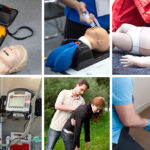When sudden cardiac arrest (SAC) and other cardiac emergencies occur, the initial response would always be the performing of chest compressions and rescue breaths on the victim. CPR is effective in delaying the occurrence of the victim’s biological death.
While CPR is proven to cause a great effect on the person’s survival, the use of external defibrillators is crucial in or out of hospital settings. External defibrillators are designed to stop the victim’s heart and restore it back to its normal rhythm, making the person conscious and alive once again. Defibrillators were once relegated to hospital settings and had to be administered by medical professionals, but Automated External Defibrillators (AEDs) are now portable, easy to use, and made available in many public settings. Access is critical as immediate use is essential for survival, if not administered in 5-7 minutes the SAC could be fatal.
Services exist in many countries to help you locate AEDs on maps to raise awareness in their communities and to help travelers ready themselves in unfamiliar areas. In the US several free apps available that help locates AEDs on a map, like Staying Alive and Pulse Point Respond. Maps can be found for the United Kingdom, New Zealand, Australia, and many other nations with a simple web search.
That is why most medical experts promote the use of AED in healthcare settings, especially those institutions that acquire a great number of people such as workplaces, schools, and even the household. This may seem optional but considering one in your place can be a game-changer for you and your family because you will never know when exactly a cardiac emergency may occur. Several AEDs have received premarket approval for in-home use, like the HeartSine Samaritan PAD and the Phillips HeartStart OnSite Defibrillator.
Importance of Safe AEDs
The federal government, through Health and Human Services, the General Service Administration, and OSHA has been promoting the use and availability of Public Access Defibrillators (PAD) in several workplaces to immediately respond in cardiac emergencies.
Good Samaritan laws in all 50 states have laws protecting against liability for use of AEDs, and some manufacturers such as Phillips Medical Systems provide limited indemnification for users of their products, meaning they will pay for damages and losses should their product fail. Every manufacturer has its own indemnity policy so be sure to understand the protection offered by the manufacturer of your particular AED model. As an employer or employee, you need to have a weekly or monthly visual inspection with a checklist in addition to manufacturer-recommended maintenance to ensure AED readiness and take action on any issues immediately. Some things to check regularly include:
- Pad storage and date. Defibrillator Pads (electrodes) must be stored at temperatures specified by the manufacturer. In the event of a sudden cardiac emergency, device readiness is critical.
- Battery installation and Audio/Visual notification system function. A simple visual inspection should be performed, and manufacturer guidelines followed to ensure that the device is in proper working order, and supplies such as gloves, razors and gloves should be checked as well.
- Inspect casing and wires connecting electrodes to the main unit for cracks. Faulty components, software issues and poorly written instruction contribute a lot to the malfunctions that an external defibrillator causes.
When the victim suffers from further injuries or death, manufacturers of the machine may be deemed responsible for this and might be taken to legal action. This goes the same for the person who is responsible for the device’s maintenance.
Conclusion
For you to be able to maximize the use of AED, it is necessary to take a CPR/AED course online. American CPR Care Association offers this type of course here at .








